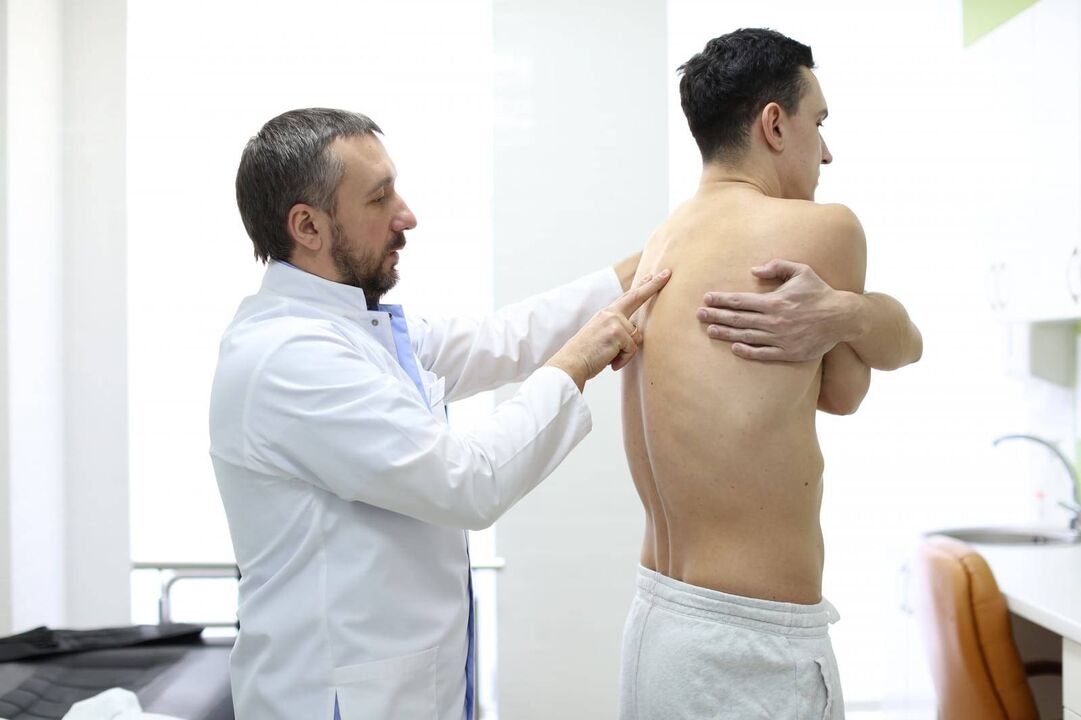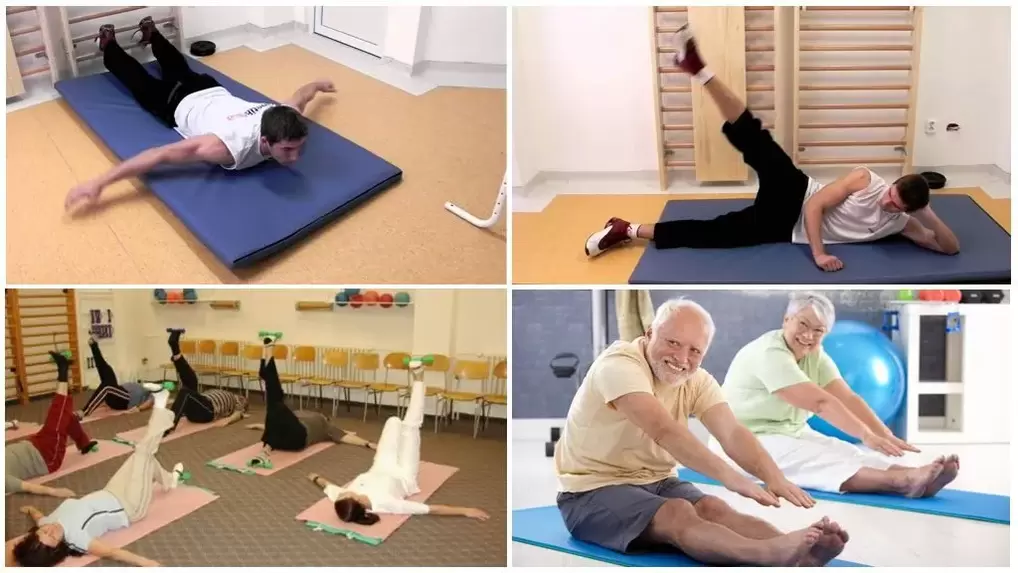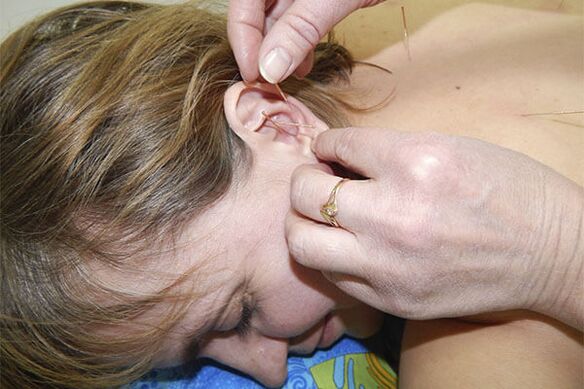
Osteochondrosis is the wear and tear of the intervertebral discs, which leads to degenerative organic changes in the spine. Osteochondrosis of the thoracic spine is considered the rarest because this part is the least mobile due to the ligaments with the ribs. But it is the one that occurs most insidiously and most violently, and develops earlier than the other types. Treatment of osteochondrosis of the thoracic spine is characterized by an integrated approach and leads to good results. With a competent approach to therapy, a person can regain mobility, lightness and pain-free life.
Causes
The main factors that cause the development of osteochondrosis of the thoracic spine are:
- Kyphosis and scoliosis. These diseases often accompany a person from birth, as an anatomical anomaly. If the kyphosis is smoothed out, then a person may not know about its existence for half of his life. Scoliosis is a curvature of the spine that leads to a disturbed distribution of muscle load. As a result, on the one hand, the muscles will be atrophied and relaxed, and on the other, they will spasm due to constant tension.
- Injuries. They may become apparent when a person injures the vertebrae in a fall, accident, or other similar circumstances. The injuries may not be noticeable. For example, spinal injuries are common due to overuse in the gym and heavy lifting.
- Flat feet. Some doctors claim that this is almost the main reason for the development of degenerative changes in any part of the spine. Flat feet disrupt the balance of the muscular corset; improper redistribution of the load leads to impaired depreciation of the vertebrae.
- Static incorrect body position for a long time. As a result of muscle overexertion, blood circulation and nutrition of muscle tissue deteriorate. Namely, they hold the spine. It is the cause not only of osteochondrosis of the thoracic spine, but also of the cervical and lumbar spine.
- Excess weight and lack of sufficient physical activity.
- Stress. Stress in itself is not as dangerous as the reaction to it. During times of stress, the adrenal glands produce excessive amounts of adrenaline, which is converted to norepinephrine. It promotes the thickening of blood vessel walls and the progression of atherosclerosis. In stressful conditions, the blood vessels narrow, which leads to a poor supply of oxygen to the muscle tissue.
- Alcohol consumption, smoking, use of other drugs and poor diet. Alcohol leaches calcium from bone tissue. Tobacco and other drugs lead to improper functioning of blood vessels. Serious mistakes in nutrition lead to obesity, lack of B vitamins and minerals.
- Improper carrying of bags and shoes.
- Gastrointestinal diseases that affect the quality of absorption of nutrients.
- Violation of water and electrolyte balance over a long period of time.
- Pregnancy. Thoracic osteochondrosis often occurs in women who are pregnant with twins or triplets.
- Metabolic syndrome.
- Autoimmune diseases, infections, intoxications.
- A genetic predisposition associated with a genetic mutation. You should not think that genetic predisposition is necessarily related to the fact that one of your close relatives suffered from osteochondrosis. Often it has nothing to do with genetics. A genetic predisposition is always a mutation of certain genes. But even so, the disease will develop only in combination with other factors.
The disease can occur both in adulthood and in youth. Every year the disease is getting younger. Therefore, it is important to recognize the problem as soon as possible by paying attention to the symptoms.
Symptoms
Degenerative changes in the thoracic spine cause great concern in humans. The chest area contains the heart, lungs, internal organs of the abdominal cavity, ribs, and in women, the mammary glands. Symptoms in this location can be similar to an attack of angina, a heart attack or pain in the stomach, mammary glands or any other adjacent organ. Therefore, when osteochondrosis is felt, it is often mistaken for other dangerous pathologies.
Symptoms and treatment of osteochondrosis of the thoracic spine are interconnected due to two types of clinical picture.
Radicular signs
Radicular symptoms:
- shooting or pain in the shoulder, armpit, or collarbone;
- impaired reflexes;
- muscle weakness;
- pain in the upper part of the chest, similar to a heart attack, in the solar plexus, in the hypochondrium, pain in the mammary glands, in the upper part of the abdomen or in the groin area.
Reflex signs
Symptoms:
- respiratory disorders such as a feeling of lack of air, pain when inhaling and exhaling, difficulty breathing;
- feeling of chills, "hedgehogs";
- feeling of disturbance in the gastrointestinal tract: nausea, loss of appetite, heartburn, diarrhea or constipation, flatulence;
- intercostal neuralgia;
- pain in the chest of a girdling nature, between the shoulder blades, during bending and straightening;
- insomnia, feeling tired from enough sleep, tiredness;
- stiffness of movement in the morning;
- deterioration of gait;
- irritability;
- decreased libido/potency.
Reflex symptoms are more vague than radicular symptoms and are often misunderstood by doctors. Therefore, it is very important to find a competent doctor who will take the patient's complaints seriously and prescribe the correct treatment for thoracic osteochondrosis, especially in the period of exacerbation.
Diagnostics
The gold standard for diagnosing thoracic osteochondrosis is an MRI of the thoracic spine and an examination by a neurologist.
MRI accurately shows the anatomical structure, changes, compression, blood flow and a visual picture of the effect on the spinal cord. Also, the study shows possible complications of the disease such as protrusions, osteophytes, hernias and their impact on blood flow.
As before, an examination by a specialist doctor plays an important role in establishing a diagnosis.
Treatment
Many have heard that it is impossible to completely get rid of osteochondrosis, but you can only slow down its development. This is a half-truth. You can get rid of hernias, osteophytes and other complications of the disease. You can regain your pain-free life and ease of movement and restore your intervertebral discs. There is a good chance to stop the destruction process, restoring the spine to its previous state as much as possible. Some managed to completely get rid of the pathology, while others did not. Everything is individual and depends on the state of health, willingness to overcome difficulties and patience.
You must be prepared for the fact that the treatment of osteochondrosis of the thoracic spine will take a long time. On average, active participation will take 1-3 months. But even then, life will not be the same because of the need for regular and proper physical activity for at least a year.
In this case, finances and time are not an excuse for refusing treatment, because you can fight the disease both in a hospital or sanatorium and at home. The most suitable option is in a sanatorium. There, the patient is supported by a group of people with the same problems, but the conditions are positive and homely. The medical staff is always tactful and caring. There you can relax and be treated without the hospital atmosphere, but with all the necessary medical services.
The therapy consists of several stages:
- pain management (wearing a special corset, taking painkillers, undergoing procedures);
- restoration of damaged spinal discs and preventive measures against the progression of the disease (physiotherapy, gymnastics, proper nutrition, psychologist's help).
Drug treatment is also used, but is considered a last resort when other methods fail. In the most severe cases and dangerous hernias, surgery is prescribed.
The most important rule is no self-medication or self-diagnosis. Mistakes can be very expensive.
Treatment at home
If you do not have time or do not have enough financial resources for treatment in a clinic or sanatorium, you can achieve impressive results in the treatment of osteochondrosis at home. The recommendations below will help you cope with the disease.
Nutrition
In the diet, it is necessary to introduce foods that help speed up the metabolism in case of excess weight and the regeneration of cartilage tissue. It is important that the food you eat is rich in nutrients, microelements, antioxidants, polyunsaturated fatty acids, vitamins and is easily digestible.
You need to eat 4-5 times a day every 2, 5-3 hours, preferably at the same time. Portions should not exceed 300 g, so as not to overload the stomach and liver. Three meals should contain 26-30 g of protein. Proteins are necessary for building muscle tissue. Thus, the metabolism will speed up, the body will stop accumulating fat, and the cells will receive constant nutrition.
The first breakfast and dinner should be mostly protein. For example, egg white and cucumber. The main principle of the first and last meal is the absence of insulin spikes, which is achieved by eliminating carbohydrates. Cucumber, although it is a carbohydrate, has a low glycemic index. Proteins without a small amount of fat and carbohydrates are not digestible.
Recommended products:
- legumes as a protein substitute for meat (beans, including legumes, lentils, peas);
- vegetables in large quantities (with the exception of starchy ones, which should be consumed with caution);
- jellies and jellies (contain natural collagen, necessary for joints);
- chicken wings (the bones must be gnawed, their contents are the most valuable);
- poultry, red meat in limited quantities;
- salmon fish, caviar and mlo;
- squid, seaweed (no more than 100 g at a time);
- olive oil, kamina oil, linseed oil (if there are no liver problems), sesame oil, adults should avoid sunflower oil;
- fruit in limited quantities with low sugar content
It is recommended to cook, steam, stew or eat all dishes fresh.
The drinking regime is mandatory, because the required amount of water ensures relief from dehydration, nutrition of cells and promotes weight loss. Daily water intake is calculated using a simple formula: 30 x weight. Tea, coffee, herbal infusions, juices and fruit drinks are not considered water.
Physical exercises

Physical activity is an integral part of the treatment of osteochondrosis of any part of the spine. The following techniques may be included:
- Gymnastics was developed by scientist Yuri Gushcho. Contains elements of dynamic and static yoga. It also advises the implementation of curing procedures. If you are interested, you can read his book "12 Keys to the Longevity Safe" in which he talks about what you need to do to live as long as possible while being active. It makes sense to believe him, because Yuri got out of his wheelchair on his own and recovered from coxarthrosis. There are many awards, thanks from the President of the Russian Federation.
- Gymnastics according to Dr. Bubnovski's technologies. His technique is quite effective and can be done at home. A set of exercises can be found online in video format, and books with full instructions are also available.
- Swimming pool. Swimming not only helps you lose weight, but also strengthens your heart, lungs and develops back muscles.
- Isometric gymnastics. This type of exercise was first developed for astronauts returning home. Exercises make it possible, without damaging the joints, to restore weakened muscles, restore flexibility and ease of movement. Gymnastics is indicated for many pathologies of the musculoskeletal system, including osteochondrosis of the thoracic spine.
- Outdoor walks. It is recommended to spend an hour every day for intensive walks, preferably in parks or along the coast. The goal is to improve cerebral circulation, muscle nutrition and mood.
- Posture correction exercises.
A complete vacation
It is necessary to develop the habit of going to bed and waking up at the same time. Ideally, go to bed at 9pm and wake up at 5-6am. During this time, the brain manages to restore the functioning of the body's internal systems, the psyche and process all the information it received the day before. This is especially important for the health of the spine.
To sleep, you need to choose the right mattress and pillow. It is better to forget about too soft or hard options.
Treatment in a hospital or sanatorium
Manual therapy
It is an action on the patient's body with the help of hands in order to restore the metabolism and give the spine the correct shape. The procedure consists of manipulations to restore joint function, relaxing massage to relieve pain and muscle tension, mobilization to improve circulation and relaxation.
The duration of treatment is about 3 months.
Massage
Both classical therapeutic and acupressure types of massage are used in the treatment of degenerative changes on the thoracic spine. The massager works with the muscle fibers of the upper back and shoulders to affect the thoracic region.
Mineral baths
During the procedure, the hemodynamics of the body changes. This means that blood is directed from the center to the periphery, and from there to the heart, which pushes it through all organs and tissues. This achieves the following effects:
- blood circulation improves;
- the nervous system is strengthened;
- The respiratory system and kidneys work better;
- adaptive properties of the body increase;
- reducing inflammation;
- relief from pain;
- toxin removal;
- skin sensitivity increases.
The chemical composition of the water affects the effect of the mineral bath on the body of a patient suffering from osteochondrosis. Water temperature affects muscle relaxation and metabolic processes.
Acupuncture

Also, this procedure is called acupuncture or acupuncture. Its essence is to act on the biological points of the human body with the help of needles. Long and short sterile needles are inserted to a depth of up to 15 mm and left for half an hour.
This seemingly simple procedure has been proven all over the world. Patient reviews indicate the following effects after completing a course of acupuncture procedures:
- relaxation;
- cessation of tinnitus and dizziness;
- increase in energy potential;
- improved blood flow;
- improvement of thought processes;
- getting rid of headache;
- relief of muscle spasms.
Laser therapy
The advantage of laser therapy is the improvement of drug penetration and the normalization of adaptive properties of the organism. During the procedure, laser beams of a certain range are exposed to the parts of the spine that need treatment. The result of exposure is an anti-inflammatory effect, normalization of metabolism in the affected area, improvement of the general condition, the process of tissue regeneration begins, and the process of degeneration stops.
As a result of a complete cycle of interventions as part of complex therapy, the degenerative process can be completely reversed.
Mud therapy
This procedure is beneficial not only for the spine, but also for the whole body. The only thing is that it cannot be used in the acute phase of osteochondrosis.
Effects of mud therapy include improvement of trophism of formations in intervertebral joints, vascular function, adaptation and recovery processes. Also, the functioning of the nervous system normalizes, the pain disappears.
Work with a psychologist
Since with osteochondrosis a person experiences constant stress, anxiety states often develop. A psychologist not only helps to get rid of them, but also stimulates in moments of despair and fatigue. A positive attitude plays an important role in treatment.
Exercise therapy
The treatment procedure is carried out in groups of several people and includes exercises taking into account the individual characteristics of the patient and his medical history. The emphasis is on improving joint function and strengthening the muscular corset. Without exercise, full recovery is unlikely.
Nordic walking
This is one of the most effective types of physical activity for osteochondrosis and is becoming more and more popular every year.
When walking with poles, 90% of muscles are toned, calories are actively burned, the load is evenly distributed throughout the body, the cardiovascular system is strengthened, the work of the intestines is improved, the nervous system and psyche are strengthened, the functions of the respiratory system are improved, insomnia disappears, they become stronger. blood vessels, a strong corset is formed around the thoracic spine.
Drug therapy
Drug therapy is used only in the acute phase of osteochondrosis and when other treatment methods are ineffective.
At the peak of the disease, painkillers are prescribed, as well as drugs that accelerate metabolic processes. Both pills and injections help.
Groups of prescribed drugs:
- Nonsteroidal anti-inflammatory drugs, which also relieve pain. Available in the form of cream, tablets and ampoules for intravenous or subcutaneous administration.
- Vasodilators. During muscle tension and severe pain, vasoconstriction occurs, which results in an increase in blood pressure and impaired oxygen supply to the brain. Vasodilators restore the vascular tone to normal.
- Muscle relaxants. This group of drugs is intended to relax and calm tense muscles. This effect initiates a series of beneficial changes such as improved blood circulation, regulation of vascular tone and pain relief. When the blood flow is normalized, the damaged tissues regenerate faster.
- Chondroprotectors and B vitamins. These are drugs that restore cartilage tissue, stopping the destruction process.
- Sedative complex. The stress of pain makes the pain worse. Irritability and anxiety trigger the sympathetic nervous system, which leads to even more muscle and blood vessel tone. Sedatives and sometimes antidepressants can break this vicious cycle.
As you can see, the treatment of osteochondrosis should be approached comprehensively, studying all the nuances. It is best to turn to experts to protect yourself from mistakes.



















